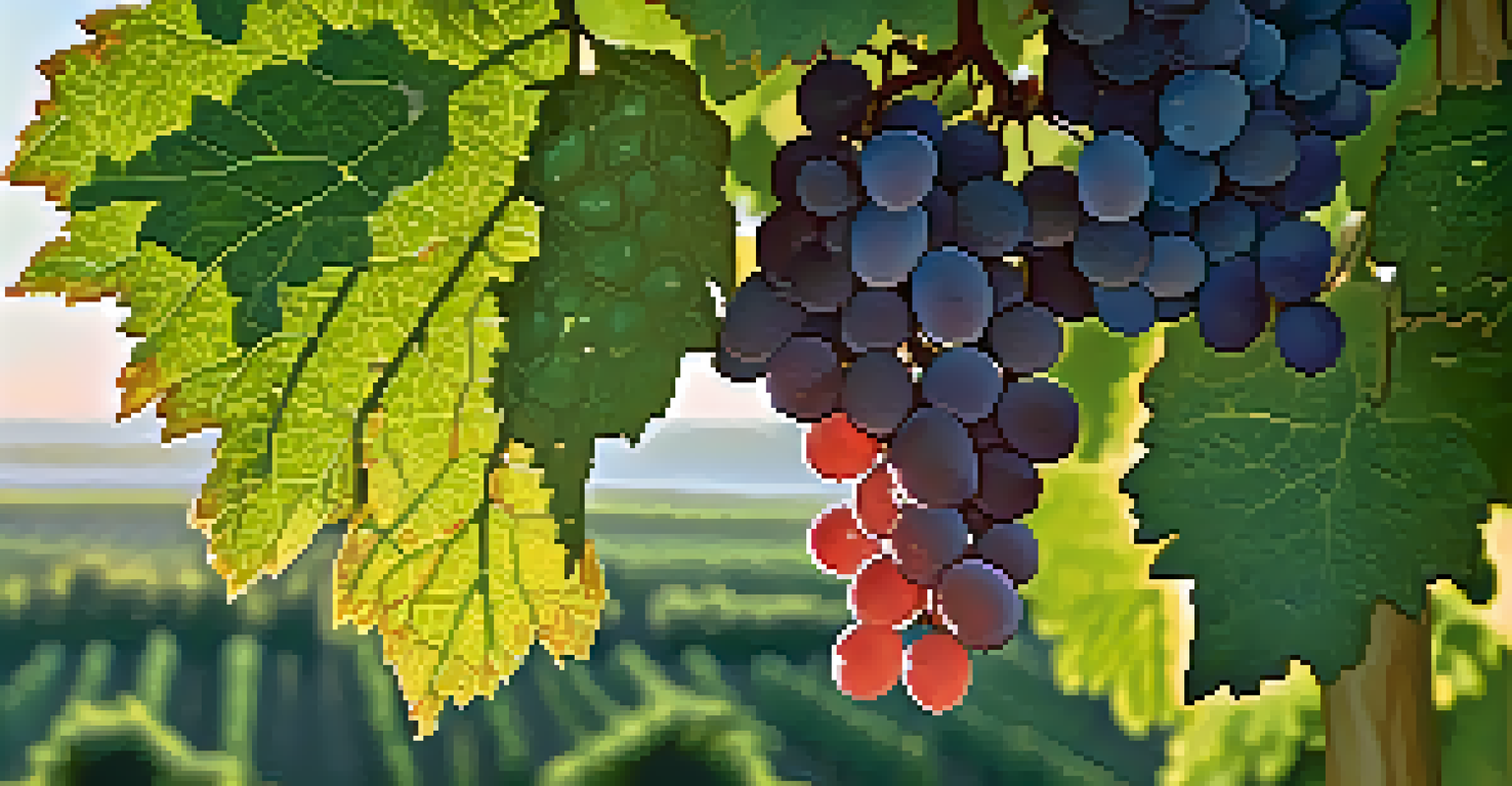The History of Wine Production in Peru's Diverse Regions

The Origins of Wine in Ancient Peru
Wine production in Peru dates back thousands of years, with evidence suggesting that ancient civilizations were already fermenting grapes around 800 AD. The Moche and Nazca cultures were among the first to cultivate vineyards, using local grape varieties to create potent beverages for rituals and celebrations. These early wine makers laid the foundation for what would evolve into a rich winemaking tradition.
Wine is sunlight, held together by water.
As time progressed, the knowledge of viticulture spread throughout the Andes, merging with local agricultural practices. The introduction of European grape varieties by Spanish colonizers in the 16th century significantly changed the landscape of wine production in Peru. This blend of indigenous techniques and European influences marked a pivotal moment in the country's viniculture history.
Today, Peru's wine heritage is celebrated not just for its historical significance but also for the unique flavors and characteristics that emerge from its diverse climates and altitudes. The country's commitment to reviving ancient practices while embracing modern techniques continues to intrigue wine enthusiasts around the globe.
Geographical Diversity and Its Impact on Wine Flavor
Peru's geographical diversity plays a crucial role in shaping the country's wine production. From the coastal regions along the Pacific Ocean to the high-altitude vineyards in the Andes, each area contributes distinct characteristics to the wines produced. The varying climates, soil types, and altitudes create a tapestry of flavors that reflect the land's unique identity.

For instance, the Ica Valley, known for its arid climate, produces robust red wines, while the cooler regions of Arequipa yield crisp whites that showcase the freshness of the grapes. This contrast is akin to the way terroir influences wine in other parts of the world, emphasizing the idea that great wines are deeply connected to their origins. As a result, Peru has emerged as a contender in the global wine scene, offering something truly special.
Ancient Roots of Peruvian Wine
Wine production in Peru dates back to 800 AD, with indigenous cultures crafting potent beverages that laid the groundwork for a rich winemaking tradition.
Furthermore, the elevation of vineyards in areas like the Colca Valley allows for a longer growing season, enhancing the fruit's ripeness and complexity. This interplay of altitude and climate not only produces exceptional wines but also tells the story of the land and its people, making each bottle a journey through Peru's rich viticultural history.
The Role of Indigenous Grapes in Peru’s Wine Scene
Indigenous grape varieties like Quebranta and Torontel are at the heart of Peru's wine production, showcasing the country's unique viticultural identity. These grapes have been cultivated for centuries, often used in traditional beverages such as Pisco, a popular Peruvian spirit. Their resilience and adaptability to local conditions make them essential to Peru's winemaking legacy.
The best wines come from the best vineyards.
Quebranta, for instance, is known for its rich, full-bodied flavor, which translates beautifully into both wine and Pisco. Many local winemakers are now embracing these indigenous varieties, focusing on crafting wines that highlight their distinctive characteristics. This shift not only honors Peru's winemaking history but also introduces wine lovers to flavors that are exclusive to this region.
In addition to their unique flavors, these indigenous grapes represent a cultural connection to the land. By prioritizing native varietals, Peruvian winemakers are promoting biodiversity and sustainability within their vineyards, ensuring that future generations can continue to enjoy the fruits of their labor.
Spanish Influence and the Introduction of European Varieties
The arrival of Spanish colonizers in the 16th century brought significant changes to Peru's wine industry. Along with their cultural and agricultural practices, they introduced European grape varieties such as Cabernet Sauvignon and Malbec. This infusion not only diversified the types of wine produced but also elevated the overall quality of Peruvian wines.
Initially, these European grapes were planted alongside indigenous varieties, creating a fascinating blend of old and new. The adaptability of these grapes to the Peruvian climate allowed winemakers to experiment and innovate, leading to the development of unique blends that reflect the essence of Peru. This evolution of wine styles helped shape the modern Peruvian wine landscape.
Indigenous Grapes Shape Identity
Grapes like Quebranta and Torontel are central to Peru's wine scene, reflecting the country's unique viticultural identity and cultural heritage.
Today, many wineries celebrate this rich heritage by producing wines that pay homage to both their indigenous roots and European influences. This fusion of flavors has made Peruvian wines increasingly popular on the international stage, showcasing the country's capacity for creativity and excellence in winemaking.
Modern Winemaking Techniques in Peru
As the world of wine continues to evolve, so too does the approach to winemaking in Peru. Innovative techniques, including organic farming and sustainable practices, are gaining momentum among local vintners. This shift is not only beneficial for the environment but also enhances the quality and authenticity of the wines produced.
Many Peruvian wineries are now adopting biodynamic practices, which focus on cultivating a harmonious relationship between the vineyard and its surroundings. This method encourages natural pest control, enhances soil health, and ultimately leads to a more vibrant and expressive wine. Winemakers are increasingly recognizing that the best wines come from a balanced ecosystem.
Moreover, technology plays a significant role in modern winemaking, from advanced fermentation techniques to precision viticulture. These innovations allow winemakers to better understand their grapes and produce wines that reflect the true character of their regions. As a result, Peru's wine industry is poised for growth, attracting attention from wine lovers and critics alike.
The Rise of Peru as a Wine Destination
In recent years, Peru has emerged as a notable wine destination, drawing both tourists and wine enthusiasts eager to explore its vineyards. Wine tourism in Peru offers visitors the chance to experience the country's rich viticultural heritage firsthand, from vineyard tours to tastings of exquisite wines. This growing interest is helping to put Peru on the global wine map.
Regions like Ica and Arequipa have become hubs for wine tourism, showcasing the country's diverse wine offerings. Many wineries have embraced this trend by creating visitor-friendly experiences, complete with guided tours and gourmet dining options. This not only enhances the appeal of the wineries but also contributes to the local economy by promoting tourism.
Peru's Emerging Wine Tourism
Peru is becoming a notable wine destination, attracting tourists eager to explore its vineyards and experience its diverse wine offerings.
As visitors flock to these regions, they are discovering the unique stories behind each bottle, connecting with the land and its people. This personal connection to the wine adds to its allure, encouraging more people to appreciate and celebrate the flavors of Peru. The country's commitment to producing high-quality wines while embracing its rich history continues to captivate wine lovers around the world.
Challenges and Opportunities in Peru's Wine Industry
Despite its successes, Peru's wine industry faces several challenges that need to be addressed for continued growth. Climate change poses a significant threat, as shifting weather patterns can impact grape yields and quality. Additionally, competition from established wine regions around the world makes it essential for Peruvian wineries to differentiate themselves in a crowded market.
However, these challenges also present opportunities for innovation and collaboration among winemakers. By sharing knowledge and resources, local vintners can develop strategies to combat climate change's effects and enhance the resilience of their vineyards. Furthermore, increased investment in research and development can lead to advancements in sustainable practices and wine production techniques.

As the industry adapts to these challenges, there is potential for Peru to carve out a niche in the global wine market. By focusing on unique varietals and sustainable practices, Peruvian winemakers can create a distinctive identity that appeals to environmentally-conscious consumers. With a commitment to quality and innovation, the future of Peru's wine industry looks promising.